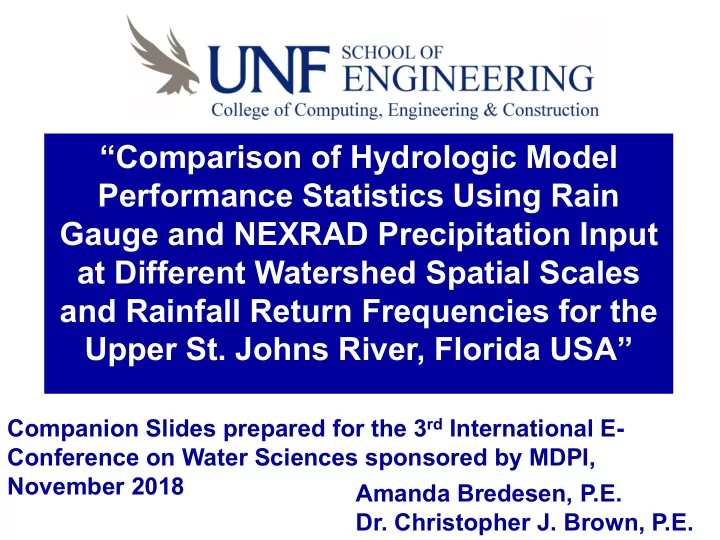

“Comparison of Hydrologic Model Performance Statistics Using Rain Gauge and NEXRAD Precipitation Input at Different Watershed Spatial Scales and Rainfall Return Frequencies for the Upper St. Johns River, Florida USA” Companion Slides prepared for the 3 rd International E- Conference on Water Sciences sponsored by MDPI, November 2018 Amanda Bredesen, P.E. Dr. Christopher J. Brown, P.E.
Study to Compare Model Data Inputs Study of two different precipitation model input types including standard rain gauges and Nexrad radar-derived data. This is a companion presentation for paper by Bredesen and Brown. General conclusion of the study is that for large basins Rain Gauge precipitation input data was about the same or slightly better than Nexrad data. For small basins, Nexrad data proved superior.
Study to Compare Model Data Inputs For higher return frequency rain events, Rain Gauge data was about the same as Nexrad data. For smaller return frequencies, Nexrad data was best.
Study to Compare Model Data Inputs General project Study Area is the Upper St. Johns River in Florida, USA:
Study to Compare Model Data Inputs General Methods Used: First, the research team developed a HEC-HMS hydrologic (rainfall-runoff) model of the Upper St. Johns watershed. Then, once the model was sufficiently calibrated and validated, the research team compared calibration statistics using two different data inputs, namely: Standard rain gauge data; Remotely-sensed data using radar estimates or Nexrad for short;
Study to Compare Model Data Inputs General Methods Used: Then, the results were also discretized into sub- catchment or sub-basin size versus degree of calibration and; Precipitation return frequency versus degree of calibration; The concept being that the additional pre and post- processing required to use the Nexrad data instead of the gauge data might not be worth it if the model calibration statistics could not be improved, e.g. what is the value of the Nexrad data versus the gauge data.
Study to Compare Model Data Inputs General model domain in Central Florida, USA; Representative sub-basins also shown to demonstrate initial model calibration and validation.
Study to Compare Model Data Inputs How about some results ?
Study to Compare Model Data Inputs Summary of Initial Model Calibration Using R 2 and Nash- Sutcliffe Efficiency Factor (NSE): Table 2. Initial model calibration performance statistics for representative basins. r 2 Gauge Location NSE Fort Drum 0.89 0.85 Blue Cypress 0.84 0.84 Penneywash 0.86 0.79 US 192 0.88 0.86 FL 520 0.98 0.98 Inlet Lake Harney 0.93 0.90
Study to Compare Model Data Inputs Summary of Degree of Model Calibration for the two different precipitation datasets using R 2 and Nash-Sutcliffe Efficiency Factor (NSE): Table 3. Coefficient of determination simulation results.
Study to Compare Model Data Inputs Summary of Degree of Model Calibration for the two different precipitation datasets using R 2 and Nash-Sutcliffe Efficiency Factor (NSE): Table 4. Nash-Sutcliffe efficiency coefficient simulation results.
Prelim Study to Revise Design Procedures Future Research: Do similar studies of other watersheds in the USA using HEC-HMS or other hydrologic models; and, Review additional storm return frequencies for the same watersheds studied in order to add validity to some of the study conclusions.
Questions Thank you for the opportunity to provide this presentation. Chris Brown – christopher.j.brown@unf.edu; Or via phone: 01-(904)-620-2811 Amanda Bredesen– aetan625@aol.com;
Recommend
More recommend